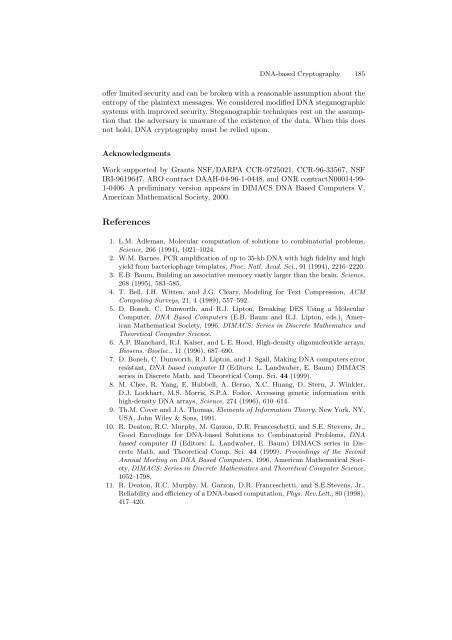LNCS 2950 - Aspects of Molecular Computing (Frontmatter Pages)
LNCS 2950 - Aspects of Molecular Computing (Frontmatter Pages)
LNCS 2950 - Aspects of Molecular Computing (Frontmatter Pages)
You also want an ePaper? Increase the reach of your titles
YUMPU automatically turns print PDFs into web optimized ePapers that Google loves.
DNA-based Cryptography 185<br />
<strong>of</strong>fer limited security and can be broken with a reasonable assumption about the<br />
entropy <strong>of</strong> the plaintext messages. We considered modified DNA steganographic<br />
systems with improved security. Steganographic techniques rest on the assumption<br />
that the adversary is unaware <strong>of</strong> the existence <strong>of</strong> the data. When this does<br />
not hold, DNA cryptography must be relied upon.<br />
Acknowledgments<br />
Work supported by Grants NSF/DARPA CCR-9725021, CCR-96-33567, NSF<br />
IRI-9619647, ARO contract DAAH-04-96-1-0448, and ONR contractN00014-99-<br />
1-0406. A preliminary version appears in DIMACS DNA Based Computers V,<br />
American Mathematical Society, 2000.<br />
References<br />
1. L.M. Adleman, <strong>Molecular</strong> computation <strong>of</strong> solutions to combinatorial problems,<br />
Science, 266 (1994), 1021–1024.<br />
2. W.M. Barnes, PCR amplification <strong>of</strong> up to 35-kb DNA with high fidelity and high<br />
yield from bacteriophage templates, Proc. Natl. Acad. Sci., 91 (1994), 2216–2220.<br />
3. E.B. Baum, Building an associative memory vastly larger than the brain, Science,<br />
268 (1995), 583–585.<br />
4. T. Bell, I.H. Witten, and J.G. Cleary, Modeling for Text Compression, ACM<br />
<strong>Computing</strong> Surveys, 21, 4 (1989), 557–592.<br />
5. D. Boneh, C. Dunworth, and R.J. Lipton, Breaking DES Using a <strong>Molecular</strong><br />
Computer, DNA Based Computers (E.B. Baum and R.J. Lipton, eds.), American<br />
Mathematical Society, 1996, DIMACS: Series in Discrete Mathematics and<br />
Theoretical Computer Science.<br />
6. A.P. Blanchard, R.J. Kaiser, and L E. Hood, High-density oligonucleotide arrays,<br />
Biosens. Bioelec., 11 (1996), 687–690.<br />
7. D. Boneh, C. Dunworth, R.J. Lipton, and J. Sgall, Making DNA computers error<br />
resistant, DNA based computer II (Editors: L. Landwaber, E. Baum) DIMACS<br />
series in Discrete Math. and Theoretical Comp. Sci. 44 (1999).<br />
8. M. Chee, R. Yang, E. Hubbell, A. Berno, X.C. Huang, D. Stern, J. Winkler,<br />
D.J. Lockhart, M.S. Morris, S.P.A. Fodor, Accessing genetic information with<br />
high-density DNA arrays, Science, 274 (1996), 610–614.<br />
9. Th.M. Cover and J.A. Thomas, Elements <strong>of</strong> Information Theory, New York, NY,<br />
USA, John Wiley & Sons, 1991.<br />
10. R. Deaton, R.C. Murphy, M. Garzon, D.R. Franceschetti, and S.E. Stevens, Jr.,<br />
Good Encodings for DNA-based Solutions to Combinatorial Problems, DNA<br />
based computer II (Editors:L.Landwaber,E.Baum)DIMACSseriesinDiscrete<br />
Math. and Theoretical Comp. Sci. 44 (1999). Proceedings <strong>of</strong> the Second<br />
Annual Meeting on DNA Based Computers, 1996, American Mathematical Society,<br />
DIMACS: Series in Discrete Mathematics and Theoretical Computer Science,<br />
1052–1798.<br />
11. R. Deaton, R.C. Murphy, M. Garzon, D.R. Franceschetti, and S.E.Stevens, Jr.,<br />
Reliability and efficiency <strong>of</strong> a DNA-based computation, Phys. Rev.Lett., 80 (1998),<br />
417–420.
















